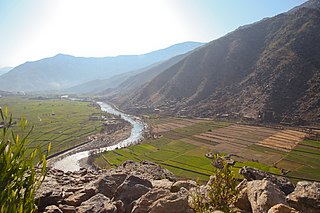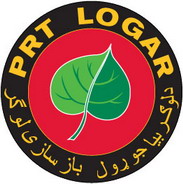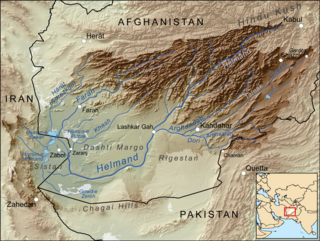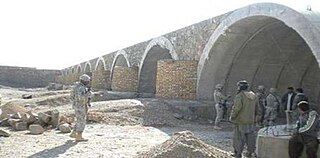
The International Security Assistance Force (ISAF) was a multinational military mission in Afghanistan from 2001 to 2014. It was established by United Nations Security Council Resolution 1386 according to the Bonn Agreement, which outlined the establishment of a permanent Afghan government following the U.S. invasion in October 2001. ISAF's primary goal was to train the Afghan National Security Forces (ANSF) and assist Afghanistan in rebuilding key government institutions; it gradually took part in the broader war in Afghanistan against the Taliban insurgency.

A Provincial Reconstruction Team (PRT) was a unit introduced by the United States government, consisting of military officers, diplomats, and reconstruction subject matter experts, working to support reconstruction efforts in unstable states. PRTs were first established in Afghanistan in early 2002, and were used in Iraq as well. While the concepts are similar, PRTs in Afghanistan and Iraq had separate compositions and missions. Their common purpose, however, was to empower local governments to govern their constituents more effectively.
Operation Athena was the Canadian Forces' contribution to the International Security Assistance Force (ISAF) in Afghanistan. The operation was divided in two phases: the first one took place from July 2003 to July 2005 in the Kabul region and the second one from August 2005 to December 2011 in the Kandahar area. The operation's main objective was to improve Afghanistan's security and governance. Operation Athena in Kandahar constituted the longest combat mission in the history of Canadian Forces. With over 40,000 Canadian military members that, at some point, entered the country—often several times—this operation constitutes the largest military deployment of the Canadian Forces since World War II.

Kapisa is the smallest of Afghanistan's thirty-four provinces and is located in the north-east of the country. It has an estimated population of 523,201 people and an area of 1,842 km2 (711 sq mi), making it the most densely populated province apart from Kabul Province. It borders Panjshir Province to the north, Laghman Province to the east, Kabul Province to the south and Parwan Province to the west. Mahmud-i-Raqi is the provincial capital, while the most populous city and district of Kapisa is Nijrab.

Asadabad, also called Chaghasarai (چغسرای), is the capital city of Kunar Province in Afghanistan. It is located in the eastern-northeastern portion of the country. The city is located within a valley at the confluence of the Pech River and Kunar River between two mountain ridgelines running along both sides of the valley from Northeast to Southwest.

Kunar is one of the 34 provinces of Afghanistan, located in the northeastern part of the country. Its capital is Asadabad. Its population is estimated to be 508,224. Kunar's major political groups include Wahhabis or Ahl-e- Hadith, Nazhat-e Hambastagi Milli, Hezb-e Afghanistan Naween, Hezb-e Islami Gulbuddin.
The Iceland Crisis Response Unit is an Icelandic para-military unit with a capacity roster of up to 200 people, of whom about 30 are active at any given time. It is operated by the Icelandic Ministry of Foreign Affairs. It is primarily designated for peacekeeping operations and was established in the 1990s to participate in operations and peacekeeping projects, including in support of NATO peacekeeping operations. That role later evolved into providing an appropriate forum for deploying personnel within other organizations such as with OSCE field missions as well as with UN DPKO, and organizations such as UNIFEM, UNRWA and UNICEF.

Below is the disposition and structure of international military forces that were participating in the War in Afghanistan in November 2012, listing deployed units under the command of the International Security Assistance Force (ISAF), which controlled both combat and reconstruction operations. During its existence from 2001 to 2014, despite the photos in this article only showing American soldiers, marines and sailors, the ISAF comprised units from many countries, including: Albania, Armenia, Australia, Belgium, Canada, Croatia, Czech Republic, Estonia, Finland, France, Georgia, Germany, Hungary, Italy, Latvia, Lithuania, Macedonia, Netherlands, New Zealand, Norway, Poland, Romania, South Korea, Spain, Sweden, Turkey, United Kingdom and others. In this article, units are assumed to be from the United States unless otherwise stated. This list is a rough and unofficial listing of units and formations.
Surkh-Rōd.(Pashto/Persian: سرخرود/ سره رود), also spelled as Surkh-Rūd or Sorkh-Rūd, also called Sra-rod or Sra- road, is a district in the northern part of Nangarhar Province, Afghanistan. The district centre is the town of Sultanpur. It has abundance of fertile land; however, it is currently facing a lack of water.

Multi National Base Tarin Kot is a former International Security Assistance Force (ISAF) installation, used after the Netherlands Armed Forces' departure by the Afghan National Army. The base was located on the outskirts of Tarinkot, the capital of Uruzgan Province in southern Afghanistan.

Provincial Reconstruction Team Logar was a Provincial Reconstruction Team that was part of the International Security Assistance Force - an international military force in Afghanistan. PRT Logar was subordinated to ISAF Regional Command East, responsible for the eastern provinces of Afghanistan. Regional Command East with its HQ in Bagram was a U.S.-run Operational Command containing units from several other NATO and non-NATO countries. The task of PRT Logar was to help the Afghan government rebuild and further develop Logar province.

The Guryak truck bridge is a bridge connecting the districts of Nurgal and Khas Kunar in Konar Province, Afghanistan. The 280-metre-long (920 ft) bridge was opened on February 17, 2009. The bridge cost $1.7 million.

Abdul Jalal Jalal is the Chief of Police of Kunar Province, Afghanistan. Jalal was described as a reformer in The Enduring Ledger, the publication of the Public Affairs department of the Combined Security Transition Command.

The Helmand and Arghandab Valley Authority (HAVA) based in Lashkar Gah, Afghanistan, originally named the Helmand Valley Authority (HVA) until its expansion in 1965, was established on December 4, 1952, as an agency of the Afghan Government. The agency was modeled on the Tennessee Valley Authority in the United States, with a remit covering lands in the provinces of Farah, Ghazni, Helmand, Herat, and Kandahar.

The Provincial Reconstruction Team in Meymaneh was an International Security Assistance Force (ISAF) command; it existed between 2004 and 2012. It was classified by NATO, as a "Provincial Reconstruction Team". It consisted of soldiers and civilians from Norway, Latvia, Macedonia, Iceland and the United States. It conducts joint operations with Afghan Security Forces in Faryab province. It is led by ISAF and began its work in 2004 when they took over from the British. The camp was moved out of the city due to several attacks and a lack of space, in 2006. It is co-located with the airstrip, north of Meymaneh. Several "FOBs" are located in Ghormach and Qeysar districts, which the PRT share with Afghan soldiers.

Dave Adams is an officer in the United States Navy. Adams commanded the USS Santa Fe (SSN-763), a nuclear submarine, in 2009. Previously he was in charge of the Khost Provincial Reconstruction Team in Afghanistan.

Tojg is a large village in Farah Province, in western Afghanistan, located about 45 kilometres southwest of the city of Farah. It has a population of around 10,000.

The Teshkan Bridge in Badashkhan is a bridge across the Kokcha River. Highway 302, which crosses the bridge, is the only road connection between Badashkhan and the rest of Afghanistan.

The Sarda Dam is located near the town of Sardeh Band, in the eastern part of Andar District of Ghazni Province of Afghanistan. Part of its reservoir, which provides fresh water to much of southern Ghazni, is in neighboring Paktika Province. In recent years, the locals proposed to turn the area into a national park, similar to the Band-e Amir National Park in Bamyan Province.
















